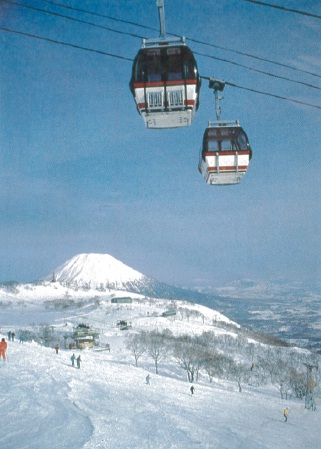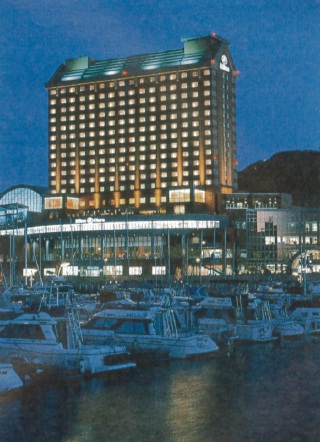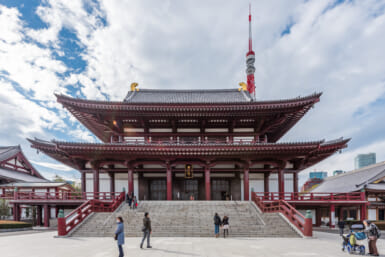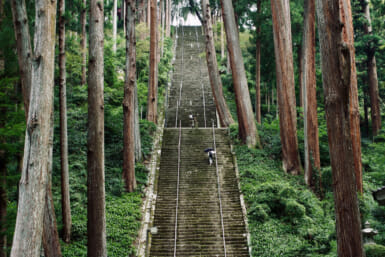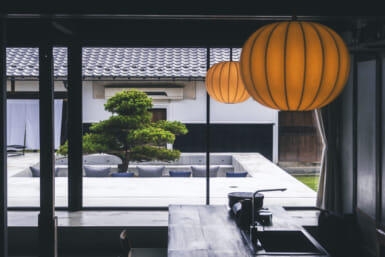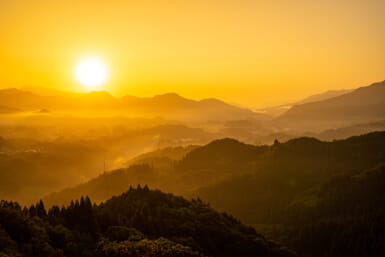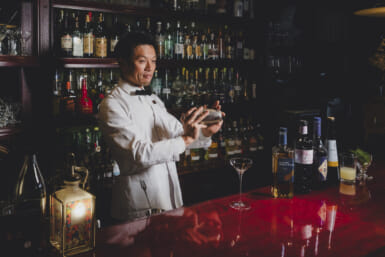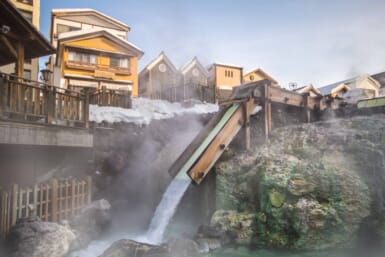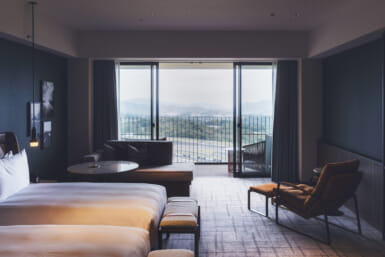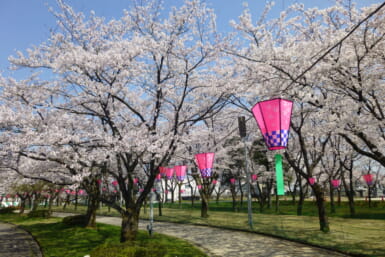“The train came out of the long tunnel into the Snow Country. The earth lay white under the night sky.” So begins the famous Nobel Prize winning novel, Snow Country, written by Yasunari Kawabata (1899 – 1972). Mr. Kawabata wrote the novel while staying in a small ryokan in Yuzawa Town, Niigata Prefecture (which now proudly refers to itself as “snow country”), in 1947. Since that time a new expressway has been built, along with the Joetsu Shinkansen, transforming the lives and economy of snow country residents.
However, the stark contrast that can often be noticed between the sunny, blue skies of northern Gunma Prefecture and the blizzard-like conditions of Niigata Prefecture can sometimes still be truly surprising, considering only about 12 kilometers (and a 10-minute ride on the Joetsu Shinkansen) separates the two.
SKIING & SNOWBOARDING IN JAPAN
For the relatively low altitude, the mountains in southern Niigata and northern Nagano facing the Japan Sea attract some of the world’s largest snowfall every winter, and even though the amount falling each year gradually decreases, in mid-February there are usually a few meters of snow on the side of roads and the pavements become snow tunnels. Photographs from many years ago show how over five or six meters used to build up, cutting people off from their homes and neighbors and making life extremely harsh and dark. In modern day-Japan, life in these regions would be harsh without the snow, as many of the towns became and are presently prosperous due to the snow which brought about the development of winter sports.
During the 1980s literally hundreds of modern resorts, complete with all the latest high speed quad lifts and gondolas, appeared all over Japan to complement some of the older resorts which had been around since the mid-1900s. The amazing ski boom that followed in the late ’80s made some of these resorts tremendously wealthy, which only increased the trend for new resort development. Ski slopes in Japan unfortunately became famous for over-crowding and tacky canned music on the slopes. While for the most part this reputation was justified, the current scene is quite different…
Until the early ’90s, skiing was seen as the thing to do. Then came the economic downturn and a sharp decrease in the numbers venturing onto the slopes. Many of the resorts became nervous about their investments, but were saved by the new phenomenon called snowboarding. As hard as it is to believe now, as little as only a few years ago ‘boarders were not welcome at most resorts in Japan, a situation which has now been completely reversed. Many resorts now attract more ‘boarders than skiers and have special snowboard parks which cater directly to the new market.
Often to the surprise of many on first coming to Japan, there are skiing and snowboarding resorts dotted on the mountainsides of most of Japan from the cold northern island of Hokkaido down to the southern island of Kyushu. There are literally hundreds of resorts in Japan, and it is true that almost everyone in Japan-wherever you live—is fairly near to some resort.
For those living in Tokyo there is a wide choice of places to go to even for a day or two. With this bewildering choice, it is hard to actually decide where to go, which is not helped by the lack of information in English about the winter sports scene.
INFORMATION IN ENGLISH
Luckily, that problem has now been largely solved with a new comprehensive guide to skiing and snowboarding on the Internet called Ski Japan which can be found at www.skijapanguide.com and is well worth repeated visits. Ski Japan has extensive information on more than 100 resorts in Japan, and also has detailed location guides, a guide to places to stay in some popular regions and a daily weather and snow condition report. There is also a newsletter, some special offers and a Ski Japan Bulletin Board for people to post messages and exchange information. The Ski Japan (not related) book by T.R. Reid, published by Kodansha, is also a good source of information, as are the Hokkaido tour companies providing services to the foreign community (see below).
MAIN SKIING & SNOWBOARDING REGIONS
The main regions to choose from are the mountainous regions of Nagano and Niigata Prefectures in Honshu which have more than 100 resorts each, and the northern island of Hokkaido. All have their strong (and weak) points, but all offer some great skiing and snowboarding.
NAGANO-KEN—OLYMPIC VENUES
Nagano Prefecture was brought into the limelight with the successful 1998 Winter Olympics which were held at various locations in the prefecture. There are some excellent resorts in Nagano with some of the most famous Olympic venues being in the Shiga Kogen region southeast of Nagano City, the Hakuba region to the north and Nozawa Onsen to the east.
SHIGA KOGEN
Shiga Kogen is actually made up of more than 20 resorts—including Yakebitaiyama (venue for the Olympic slalom course), Okushiga, Ichinose Family and Kumanoyu resorts, but a popular ticket allowing you to use all of the slopes is available (and recommended). Actually using all the slopes in such a wide area in a day would be impossible, and you could easily spend three or four days at Shiga without getting bored of the terrain.
HAKUBA
Hakuba is similar in that there are a number of resorts near each other, but they lack the all-mountain lift pass that makes Shiga so attractive. That fact, however, should not put people off going to Hakuba, as it offers some very good resorts and spectacular surroundings. The places to look out for in the Hakuba region are Happone (Olympic downhill course), Hakuba 47, Hakuba Goryu and Tsugaike Kogen, among others.
NOZAWA ONSEN
Nozawa Onsen has a special place in the history of skiing in Japan. Nozawa regards itself as the birthplace of Japanese skiing, because of the fact that Schneider-san visited Nozawa to teach European-style skiing to the Japanese. Schneider-san was one of the first to bring (then) advanced skiing equipment to Japan, and he has a run named after him at Nozawa. He played an important part in changing the image of skiing in Japan from a means of transportation to the fact that people could actually enjoy skiing as a sport. Nozawa commemorates this and more in the Japan Ski Museum at the bottom of the Schneider Slope, which provides a fascinating background to the history of the sport in Japan. Nozawa also has some excellent slopes (and, for the first time, this year will allow snowboarders onto some of them). Nozawa Onsen village is actually popular all-year round for its abundant onsen hot springs. There are countless public baths in Nozawa and almost all accommodations in the village will have their own baths. Even though Nozawa has hosted numerous international ski events and welcomes many foreign visitors each year, the village keeps its traditional Japanese charm and is highly recommended.
All of the above Nagano Resort regions (Shiga Kogen, Hakuba and Nozawa) are all well known for good snow conditions and a wide selection of slopes that are suitable for all levels of skier or snowboarder.
GETTING THERE
Nagano is now fairly easily accessible, with the introduction of the Nagano Shinkansen for the Winter Olympics. Buses to the various resorts can be found at the station. For those traveling by car, take the Kanetsu Expressway out of Tokyo and then onto the Joshinetsu Expressway.
NUGATA-KEN—CONVENIENCE & CHOICE
The southern part of Niigata Prefecture, and in particular the towns of Yuzawa (the main station is called Echigo Yuzawa) and the adjoining Shiozawa Town are surely the most convenient location for those living in Tokyo. It is even very possible to use one of the many resorts in Yuzawa for a day trip from Tokyo, but it is a good idea to use Yuzawa as a base and stay in one of the many places in Yuzawa Town to make the most of the sheer choice of resorts and slopes. There are about 25 resorts all within 20 minutes of the main Yuzawa station (more than ten of these are less than ten minutes away). Among the more well-known resorts here are GALA Yuzawa, Naeba, Iwappara, NASPA Ski Garden, Ishiuchi Maruyama, Joetsu Kokusai and the wonderful Kagura Tashiro Mitsumata, a great place for those with some experience and looking for good snow conditions and a selection of good runs. One special deal that deserves a mention is the one-day lift ticket that allows you to use GALA Yuzawa, Ishiuchi Maruyama and Yuzawa Kogen, making for a huge area with a great selection of slopes to choose from.
GETTING THERE
The region is very easy to get to by using the Joetsu Shinkansen from Tokyo to Echigo Yuzawa. The journey takes about 70 minutes. On arrival at the station the very efficient free shuttle bus services take guests to the various resorts. By car, take the Kanetsu Expressway from Nerima Interchange to the Yuzawa Interchange-the journey should take just two hours, although delays because of the weather and traffic are common.
HOKKAIDO—FOR THE BEST POWDER SNOW
Hokkaido is, in most true powder snow enthusiasts’ minds, the best place to ski or ‘board in Japan. Large resorts, almost guaranteed powder snow, great runs and lack of crowds —all the things skiers and ‘boarders dream of—can be found in Hokkaido, and at prices lower than you may think. One major difference between Hokkaido and the slopes in Nagano and Niigata is the distance—the trip requires a flight and at least a few days, but for those who make the trek, it is worth it.
JAL’s domestic tour operating subsidiary offers a wide range of ski and snowboard packages, all easily reached by air from Haneda Airport. The JAL Story tours are attractive in terms of variety and price and there are a number of Tokyo travel agents specializing in serving the international community that have English leaflets and web sites.
One such is Beltop Travel (3544-0939, www.beltop.com) who have been marketing ski tours based on the JAL Story packages to the foreign community for more than a decade. “A key point about these packages for the non-Japanese traveler is their seamlessness,” says Michel Mertens of Beltop. “The cost includes round-trip flights to Hokkaido where at Sapporo (Chitose) Airport, customers are met at the JAL Story desk. From here they take buses to their ski resort and hotel. You don’t need to be a linguist.”
JAL Story buses operate regularly to and from featured resorts and Sapporo airport throughout the season. Toppan Travel (5403-2538) is another travel agent providing services to the foreign community.
A three-day, two-night package to Sapporo, featuring stays in city hotels and bus transport out to the slopes of Mount Teine, for example, is a real bargain, starting from as little as ¥29,800. Special extras are also available – for example a “Winter Passport” at designated resorts (including a day’s free lift pass, one day’s ski rental, lunch and dinner), and skiing and snowboard lessons. At Mount Teine, JAL Story customers get a 90-minute ski lesson for only ¥1,000— these lessons are held daily. Another example of good value is the Sapporo stay course. A typical three-day and two-night trip for two people sharing a room on weekends after mid-January may cost between ¥40,000 to ¥50,000 (including return airfare, airport bus to hotel and return, and breakfasts).
Both Beltop Travel and Toppan Travel offer a wide variety of other tours to many of the popular resorts in Hokkaido and can be contacted for further information.
The attractive and elegant Hilton Otaru has inaugurated an attractive ski package for skiers and hot-spring lovers. The package is in conjunction with the nearby Kiroro Snow World which is an elaborate and challenging complex of ski runs achieving the peak elevation of 1,180 meters with dozens of ski runs providing something for every degree of skiing skill.
The Hilton Otaru package includes an all-day “passport” to Kiroro Snow World plus free admission to Freizeit, the biggest sports club in Hokkaido within the Mycal Otaru complex. Visitors can enjoy seven huge baths, three kinds of saunas, a large pool with slides, and much more.
This Hilton Otaru package will be in effect until Mar. 31, 2000. Accommodations are going for ¥16,000 per person in twin or double rooms, ¥14,000 for triple occupancy. Included are a lavish breakfast buffet, the all-day “passport” to Kiroro Snow World, taxi transportation between the hotel and the Kiroro complex (about 40 minutes each way), admission tickets for the Freizeit. These prices include service, but not tax.
Reservations can be made by calling Hilton Otaru, (0134) 21-3111 or fax, (0134) 21-3322.
The Hokkaido Tourist Association has explanatory brochures in English, outlining skiing opportunities throughout Japan’s massive northernmost island. The Tokyo office phone number of the tourist bureau is 3214-2481.
THE COSTS
A one-day lift ticket at most resorts costs around ¥4,000, with a variety of other tickets available at most resorts, including half-day, “nighter” or two-day alternatives. All ski and snowboard resorts have rental facilities for ski equipment. The standard charges at ski-rental services at hotels and resorts may vary slightly, but as a guideline, a ski set (boots, skis and poles) cost is about ¥3,000-¥4,000 per day. Snowboard rental is about ¥4,000 a day. Some, however, own their own equipment, and the easiest way of shipping skis and boots is to use one of the excellent home delivery services (or takyubin). For only ¥2,000, you can send the packages to your resort or hotel, where it will be waiting for you on arrival.
INTO SNOW COUNTRY
The trains still come out of long tunnels and into the various “snow countries” of Japan although what awaits passengers now is rather different than the environment Kawabata experienced more than 50 years ago. Instead of the desolate wintry scenes of old, the high-speed bullet trains now take people out of the city and into breathtaking surroundings complete with modern winter snow resorts. Not taking advantage of the superb winter sports on offer in Japan seems to be such a waste of a great opportunity.
Not only are skiing and snowboarding great fun, but also they provide good exercise, fresh air and a chance to take in some of Japan’s spectacular mountainous scenery, made all the more dramatic.

